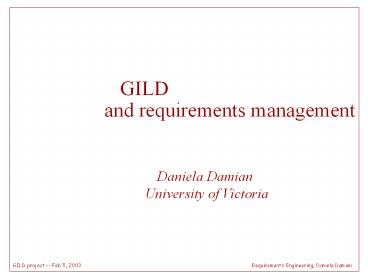Intro to 481 - PowerPoint PPT Presentation
Title:
Intro to 481
Description:
A requirement is a feature of the system or a description of something the ... Drawn by Polly Allen in Seng310, Spring 2003. Requirements Engineering, Daniela Damian ... – PowerPoint PPT presentation
Number of Views:43
Avg rating:3.0/5.0
Title: Intro to 481
1
GILD
and requirements management
Daniela Damian University of Victoria
2
Outline
- What is requirements and the process of their
engineering - Goals and requirements, and our project
- What vs. How or Requirements vs. Design
- Requirements and project management
- Activity phases
- Practical considerations
3
Requirements and their engineeringin Software
Engineering
- A requirement is a feature of the system or a
description of something the system is capable of
doing in order to fulfill the systems purpose. - Related to
- Motivations, interests, goals, needs, wishes
- Different stakeholders in the project
- Requirements engineering a complex phenomenon,
little understood and often underestimated
4
Our project thought provokin
Research endeavor Software development project
Different stakeholders Goals Research questions Different stakeholders Software requirements
- Our Project Management
- Defining our goals
- Deriving software requirements to map these goals
(rationale for work) - Continually checking for progress re goals and
requirements
5
Our project - Thought provoking
6
(No Transcript)
7
Importance of getting it right
- Failures to understand and manage requirements is
the biggest single cause of cost and schedule
over-runs - A study run by Standish Group
- surveyed 350 companies about their over 8000
software projects - results 31 - canceled before they were
completed - only 9 were delivered on time and cost.
8
Importance of getting it right
- Causes
- incomplete requirements (13.1)
- lack of user involvement (12.4)
- lack of resources (10.6)
- unrealistic expectations (9.9)
- lack of executive support (9.3)
- changing requirements and specifications (8.7)
- lack of planning (8.1)
- system no longer needed (7.5)
9
Requirements process and its activities
10
Requirements management
- Activity phase
- Elicitation/definition
- Analysis and modeling
- Negotiation
- Documentation/specification
- What you are actually doing
- Identify stakeholders
- Analyze the requirements gathered for
ambiguities, completeness, inconsistencies, etc. - Resolve conflicts (find trade-offs)
- Maintain a repository of requirements/issues/trace
ability links among all these
11
The What vs. How and the development life-cycle
12
Establishing Requirements
- Aim to make them as clear, specific and
unambiguous as possible - There are many different kinds of requirements
- Functional requirements
- E.g. for a website that the time to download any
complete page is less than 5 seconds - Non-functional
- E.g. that the system runs on many platforms such
as PC, Mac, Unix - Data requirements
- E.g. type, persistence, accuracy of data
processed by the system - Environmental requirements or context of use
- E.g. ATMs operating in busy or public areas
- User requirements
- E.g. system serves novices as well as experts
users - Usability requirements
- E.g. efficiency, safety
13
Requirements identification techniques
- Questionnaires
- Interviews
- Focus groups and workshops
- Naturalistic observation
- Studying documentation
14
Sources of requirements
15
Questionnaires
- Closed-ended questionnaire
- Leaves no room for individual comments from the
respondent - Pre-set responses for each question
- Open-ended questionnaire
- Respondent replies to questions in their own
words - Combine closed-ended and open-ended questions
16
Interviews
- Interviews tend to be one on one and only elicit
one persons perspective - Interviews can be
- structured,
- unstructured or
- semi-structured
- depending on how rigorously the interviewer
sticks to a prepared set of questions
17
Focus Groups and Workshops
- Sessions with a group of stakeholders to discuss
issues and requirements - These sessions can be very structured with set
topics for discussion, or can be unstructured - Require a facilitator who can keep the discussion
on track and provide focus and redirection when
appropriate
18
Naturalistic Observation
- Observation involves spending some time with the
stakeholders as they go about their day-to-day
tasks - A member of the design team shadows a
stakeholder, making notes, asking questions, and
observing what is being done in the natural
context of the activity
19
Studying Documentation
- Manuals are a good source of data about the steps
involved in an activity (e.g. Procedures and
rules) - Studying documentation is good for understanding
legislation and getting some background
information on the work - It is an idealized account of the work practices
20
Choosing among data gathering techniques
USER GROUP SIZE / AVAILABILITY
Small
Large
Questionnaires
Focus Groups
Interviews
Documentation
TYPE OF DATA NEEDED
Specific
General
Interviews
Questionnaires, Documentation
Focus Groups, Naturalistic Observation
Drawn by Polly Allen in Seng310, Spring 2003
21
Choosing among data gathering techniques
- Focus on identifying the stakeholders needs
- Involve all the stakeholder groups
- Use a combination of data gathering techniques
- Support the data-gathering sessions with suitable
props, such as task descriptions and prototypes
if available - Run a pilot session if possible to ensure that
your data-gathering session is likely to go as
planned
22
Requirements management practical considerations
- Requirements management expectations
management - Safety (sanity) checks
- define a minimal set of requirements feasible
within project parameters - define meaningful subsequent project artifacts
e.g. design, tests, implementation - keep track of progress/changes/coverage of
requirements
23
Our project
Research endeavor Software development project
Different stakeholders Goals Research questions Different stakeholders Software requirements
- Our Project Management
- Defining our goals
- Deriving software requirements to map these goals
(rationale for work) - Continually checking for progress re goals and
requirements
24
(No Transcript)































